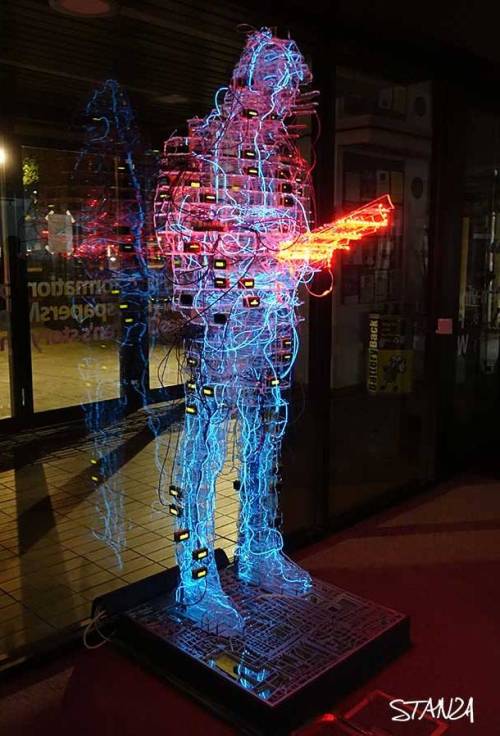Item added to basket:
{{_page.AddedItem.TotalPriceText}}
Suggested Queries
- {{query}}
- {{suggestions.ScopedQuery}} in {{scope}}
Brands
- {{brand.contentName}}
Categories
- {{tier.contentName}}
Other Suggestions
- {{page.contentName}}
When we sell 100 units of an OLED display, we are always a little intrigued about what they are being used for. Perhaps something more than a display in a PLC, or an output for a home-made electronics project? So it is always interesting to discover that they have actually helped to create something truly unique.
Ian Steele, who is an expert in electronics, audio and software development, worked with conceptual artist Stanza on The Reader, a six-foot high work of electronic installation art which first went on display in 2015.
The figure in The Reader is the artist himself, depicted wearing a hoodie and reading a book, but the body is covered with the displays, wired up to Arduinos, showing random live data. What does it represent? In the words of the artist himself, “the sculpture becomes a pulsing algorithmic heartbeat. The artwork explores new ways of thinking about life, the emergence and interaction within public space, and how this affects the socialization of space”.
The idea behind the piece, as Steele explains, is to "show how embedded technologies will become part of our everyday lives".
"I was approached by Stanza after he was commissioned to create ideas for some pieces to be shown as part of an exhibition in Milton Keynes Library". While Stanza worked on the Perspex structure, which was put together in blocks created from a 3D scan of the artist's body, Steele developed the electronics. "I used 100 OLED displays bought from Rapid to visualize the data. The data comes from a large database of books from the British Library. It was important to make the wires and control boards part of the piece. I used six Arduino Mega boards as nodes that control 16 displays. I wrote a custom app for Mac OSX that reads and processes the data and sends it to the display nodes. It also incorporates L-wire and flexi LED strips".
The sculpture is currently working its way through reading all the books published since 1952 via a British Library open source data set. But the work can be adapted and customised to read stock exchange data, DNA data, live news and social media feeds.

The Reader by Stanza
"I have worked with Stanza for about 10 years", says Steele. "I saw some of his work at the ICA in London and have worked on various projects over the years. My strength is in working out the technical processes to realise an artistic concept and I like the mixture of art, software and hardware".
We asked Steele, who works under the name 'Usermation', to explain a little more about what he does in electronics and software. "Pretty much anything! I need to be a good all-rounder. I did an apprenticeship in electronics (aerospace R&D) and I also have an MSc in IT usability and interface design. I could be building hardware around Arduino or Raspberry Pi platforms or programming a desktop application on OSX".
Before focusing full time on 'Usermation', Ian worked in music technology for some of the world's leading artists, including Joan Armatrading, World Party and the Bee Gees, helping to maintain the sound quality of concert performances. "I was lucky enough to travel around the world on large concert tours, making computers, MIDI and audio kit work reliably together. I've dragged my kit to stadiums in Swaziland, and castles in Germany. The most important thing to take? A soldering iron and a multimeter!".
"The highlight for me was working on a big New Year millennium celebration show for the Bee Gees in the USA".
"All sorts really. Connectors, cable and LEDS most recently. Rapid has a good range of stuff and understands making, creative technology and the needs of education. I like the Raaco 123761 storage drawers you stock and have several of them. I had some PCB connectors that were hard to track down, but Rapid still had them in stock".
If you would like to see 'The Reader', it is due to continue its tour in April at the European Media Art Festival in Osnabruck, and is next on show in the UK at the Foundation for Art and Creative Technology in Liverpool in June. Ian's next project is for ceramics artist Adam Hoyle, working on a tiny controller board for LED strip lights.